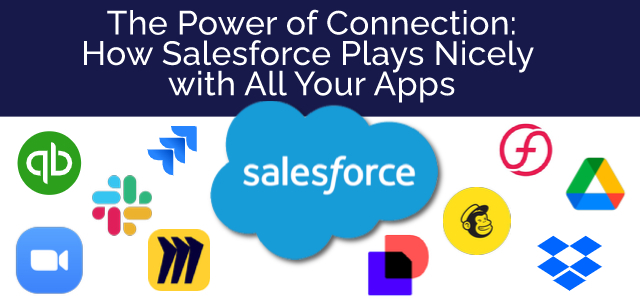The Power of Connection: How Salesforce Plays Nicely with All Your Apps
Estimated reading time: 4 minutes
Juggling a dozen apps to run your business can feel like a constant act of precariously balanced chaos. You’ve got your trusty CRM (Salesforce®, naturally!), a marketing automation whiz-kid, and a whole arsenal of other specialized tools – accounting software, document sharing, project management… the list goes on. But what if these tools never quite click? What if using one means putting another down, disrupting your workflow, and leaving data scattered like dropped juggling pins?
That’s where integrations come in, and Salesforce shines in making those connections seamless. Imagine a world where your apps work together, not against each other. Information flows freely, tasks run smoother than a well-oiled machine, and you can finally ditch the juggling act. Sounds pretty good. Let’s dive into the world of Salesforce integrations and see how they can transform your business.
How Does Salesforce Integration Work?
Salesforce offers a variety of ways to connect with other apps. Here are two common methods:
- Pre-built Integrations: The Salesforce AppExchange is a treasure trove of pre-built integrations for popular business applications like DocuSign, Google Drive, and Mailchimp. Think of it as an app store designed to connect Salesforce with the tools you already use. Installing a pre-built integration is usually as simple as a few clicks, and often requires no coding knowledge.
- API Integration: For applications not on the AppExchange, or more complex workflows, Salesforce offers robust APIs (Application Programming Interfaces). APIs act as messengers between Salesforce and other applications, allowing them to exchange data. While API integrations require some technical expertise to set up, they offer a high degree of customization.
Salesforce and MuleSoft: A Powerful Partnership
For businesses with a complex IT landscape, MuleSoft can be a game-changer. MuleSoft® is an integration platform that acts as a central hub, connecting Salesforce to all your other applications, regardless of whether they have pre-built integrations with Salesforce or not. Think of MuleSoft as a universal translator, ensuring all your applications speak the same language and data can flow freely between them.
Here’s an example: Let’s say you use a legacy ERP system (Enterprise Resource Planning) that doesn’t have a native integration with Salesforce. MuleSoft can bridge the gap, allowing data to flow seamlessly between the two systems. This can be crucial for tasks like order fulfillment or inventory management, ensuring everyone in your organization has access to the most up-to-date information.
Benefits of Salesforce Integration
The advantages of integrating Salesforce with other applications are numerous. Here are just a few:
- Improved Efficiency: By automating data transfer, integrations eliminate manual data entry, saving your team valuable time and reducing the risk of errors.
- Enhanced Collaboration: Integrations ensure everyone in your organization has access to the same customer data, leading to better collaboration and communication.
- Increased Productivity: Streamlined workflows and automated tasks free up your team to focus on more strategic initiatives.
- Improved Customer Experience: With a holistic view of the customer journey across different applications, you can provide a more personalized and responsive experience.
- Better Data-Driven Decisions: Integrations allow you to consolidate data from various sources, giving you a clearer picture of your business and enabling you to make data-driven decisions.
Getting Started with Salesforce Integrations
Whether you’re a small business or a large enterprise, there’s a Salesforce integration solution for you. Here are a few steps to get started:
- Identify Your Needs: First, consider your specific business needs and workflows. What applications do you use the most? Where do data silos exist?
- Explore the AppExchange: Browse the Salesforce AppExchange to see if there are pre-built integrations for your desired applications.
- Consult a Salesforce Expert: If you need help with more complex integrations or API development, consider working with a certified Salesforce consultant.
Summary
Salesforce’s robust integration capabilities allow you to create a unified business ecosystem, where all your applications work together seamlessly. This translates to a more efficient, productive, and customer-centric organization. So, ditch the data silos and embrace the power of connection. With Salesforce integrations, the possibilities are endless.
How AdVic Can Help
AdVic’s certified, experienced, and passionate integration consultants team up with businesses to turn legacy point-to-point integrations into a scalable architecture that your business can grow with. How can we help your business today? Quickly reach us here.
Related Resources:
Set Up Your Salesforce Org for Integration with MuleSoft
Replace Repetitive Processes and Tasks with MuleSoft RPA
Subscribe to the AdVic Salesforce Blog on Feedly:




